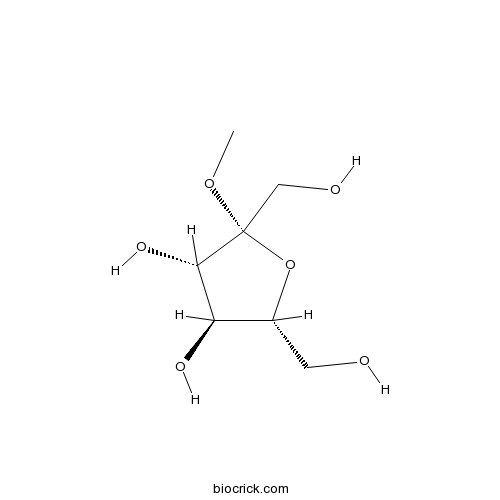Methyl beta-D-fructofuranosideCAS# 13403-14-0 |

Quality Control & MSDS
3D structure
Package In Stock
Number of papers citing our products

| Cas No. | 13403-14-0 | SDF | Download SDF |
| PubChem ID | 128889 | Appearance | Powder |
| Formula | C7H14O6 | M.Wt | 194.2 |
| Type of Compound | Miscellaneous | Storage | Desiccate at -20°C |
| Solubility | Soluble in Chloroform,Dichloromethane,Ethyl Acetate,DMSO,Acetone,etc. | ||
| Chemical Name | (2R,3S,4S,5R)-2,5-bis(hydroxymethyl)-2-methoxyoxolane-3,4-diol | ||
| SMILES | COC1(C(C(C(O1)CO)O)O)CO | ||
| Standard InChIKey | JPHVNZOOBXUCDJ-MVIOUDGNSA-N | ||
| Standard InChI | InChI=1S/C7H14O6/c1-12-7(3-9)6(11)5(10)4(2-8)13-7/h4-6,8-11H,2-3H2,1H3/t4-,5-,6+,7-/m1/s1 | ||
| General tips | For obtaining a higher solubility , please warm the tube at 37 ℃ and shake it in the ultrasonic bath for a while.Stock solution can be stored below -20℃ for several months. We recommend that you prepare and use the solution on the same day. However, if the test schedule requires, the stock solutions can be prepared in advance, and the stock solution must be sealed and stored below -20℃. In general, the stock solution can be kept for several months. Before use, we recommend that you leave the vial at room temperature for at least an hour before opening it. |
||
| About Packaging | 1. The packaging of the product may be reversed during transportation, cause the high purity compounds to adhere to the neck or cap of the vial.Take the vail out of its packaging and shake gently until the compounds fall to the bottom of the vial. 2. For liquid products, please centrifuge at 500xg to gather the liquid to the bottom of the vial. 3. Try to avoid loss or contamination during the experiment. |
||
| Shipping Condition | Packaging according to customer requirements(5mg, 10mg, 20mg and more). Ship via FedEx, DHL, UPS, EMS or other couriers with RT, or blue ice upon request. | ||
| Structure Identification | J Nat Prod. 2005 Apr;68(4):592-5.Chemical constituents of the fruits of Morinda citrifolia (Noni) and their antioxidant activity.[Pubmed: 15844957]
|

Methyl beta-D-fructofuranoside Dilution Calculator

Methyl beta-D-fructofuranoside Molarity Calculator
| 1 mg | 5 mg | 10 mg | 20 mg | 25 mg | |
| 1 mM | 5.1493 mL | 25.7467 mL | 51.4933 mL | 102.9866 mL | 128.7333 mL |
| 5 mM | 1.0299 mL | 5.1493 mL | 10.2987 mL | 20.5973 mL | 25.7467 mL |
| 10 mM | 0.5149 mL | 2.5747 mL | 5.1493 mL | 10.2987 mL | 12.8733 mL |
| 50 mM | 0.103 mL | 0.5149 mL | 1.0299 mL | 2.0597 mL | 2.5747 mL |
| 100 mM | 0.0515 mL | 0.2575 mL | 0.5149 mL | 1.0299 mL | 1.2873 mL |
| * Note: If you are in the process of experiment, it's necessary to make the dilution ratios of the samples. The dilution data above is only for reference. Normally, it's can get a better solubility within lower of Concentrations. | |||||

Calcutta University

University of Minnesota

University of Maryland School of Medicine

University of Illinois at Chicago

The Ohio State University

University of Zurich

Harvard University

Colorado State University

Auburn University

Yale University

Worcester Polytechnic Institute

Washington State University

Stanford University

University of Leipzig

Universidade da Beira Interior

The Institute of Cancer Research

Heidelberg University

University of Amsterdam

University of Auckland

TsingHua University

The University of Michigan

Miami University

DRURY University

Jilin University

Fudan University

Wuhan University

Sun Yat-sen University

Universite de Paris

Deemed University

Auckland University

The University of Tokyo

Korea University
- Phaseollin
Catalog No.:BCN4816
CAS No.:13401-40-6
- d-Laserpitin
Catalog No.:BCN3616
CAS No.:134002-17-8
- 4-Hydroxy-3,5-dimethoxybenzaldehyde
Catalog No.:BCN6186
CAS No.:134-96-3
- Lobeline Sulphate
Catalog No.:BCC8203
CAS No.:134-64-5
- (-)-Lobeline hydrochloride
Catalog No.:BCC6927
CAS No.:134-63-4
- Azaguanine-8
Catalog No.:BCC4629
CAS No.:134-58-7
- Pelargonidin chloride
Catalog No.:BCN3111
CAS No.:134-04-3
- Sodium ascorbate
Catalog No.:BCC4719
CAS No.:134-03-2
- Peonidin chloride
Catalog No.:BCN3016
CAS No.:134-01-0
- CUDC-907
Catalog No.:BCC2154
CAS No.:1339928-25-4
- Fmoc-Lys(2-Cl-Z)-OH
Catalog No.:BCC3513
CAS No.:133970-31-7
- Aristololactam I
Catalog No.:BCN2456
CAS No.:13395-02-3
- H-Ala-OtBu.HCl
Catalog No.:BCC3194
CAS No.:13404-22-3
- Selaginellin F
Catalog No.:BCN6420
CAS No.:1340493-24-4
- (RS)-4-Carboxy-3-hydroxyphenylglycine
Catalog No.:BCC6598
CAS No.:134052-66-7
- (R)-4-Carboxyphenylglycine
Catalog No.:BCC6602
CAS No.:134052-68-9
- (S)-4-Carboxyphenylglycine
Catalog No.:BCC6603
CAS No.:134052-73-6
- Ponasterone A
Catalog No.:BCN6184
CAS No.:13408-56-5
- TP-0903
Catalog No.:BCC6462
CAS No.:1341200-45-0
- INCB8761(PF-4136309)
Catalog No.:BCC1649
CAS No.:1341224-83-6
- Fmoc-Tyr(PO3Bzl2)-OH
Catalog No.:BCC3566
CAS No.:134150-51-9
- Methylcobalamin
Catalog No.:BCC5188
CAS No.:13422-55-4
- RKI-1447
Catalog No.:BCC1903
CAS No.:1342278-01-6
- Daphnelantoxin B
Catalog No.:BCN3228
CAS No.:134273-12-4
Chemical constituents of the fruits of Morinda citrifolia (Noni) and their antioxidant activity.[Pubmed:15844957]
J Nat Prod. 2005 Apr;68(4):592-5.
Purification of a n-BuOH-soluble partition of the MeOH extract of Morinda citrifolia (Noni) fruits led to the isolation of two new iridoid glucosides, 6alpha-hydroxyadoxoside (1) and 6beta,7beta-epoxy-8-epi-splendoside (2), as well as 17 known compounds, americanin A (3), narcissoside (4), asperuloside, asperulosidic acid, borreriagenin, citrifolinin B epimer a, citrifolinin B epimer b, cytidine, deacetylasperuloside, dehydromethoxygaertneroside, epi-dihydrocornin, d-glucose, d-mannitol, methyl alpha-d-fructofuranoside, Methyl beta-D-fructofuranoside, nicotifloroside, and beta-sitosterol 3-O-beta-d-glucopyranoside. The structures of the new compounds were determined by spectroscopic data interpretation. Compound 4, borreriagenin, cytidine, deacetylasperuloside, dehydromethoxygaertneroside, epi-dihydrocornin, methyl alpha-d-fructofuranoside, and Methyl beta-D-fructofuranoside were isolated for the first time from M. citrifolia. The antioxidant activity was evaluated for all isolates in terms of both DPPH and ONOO(-) bioassays. The neolignan, americanin A (3), was found to be a potent antioxidant in these assays.


